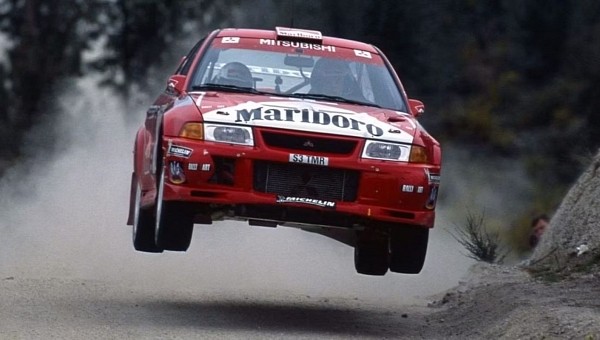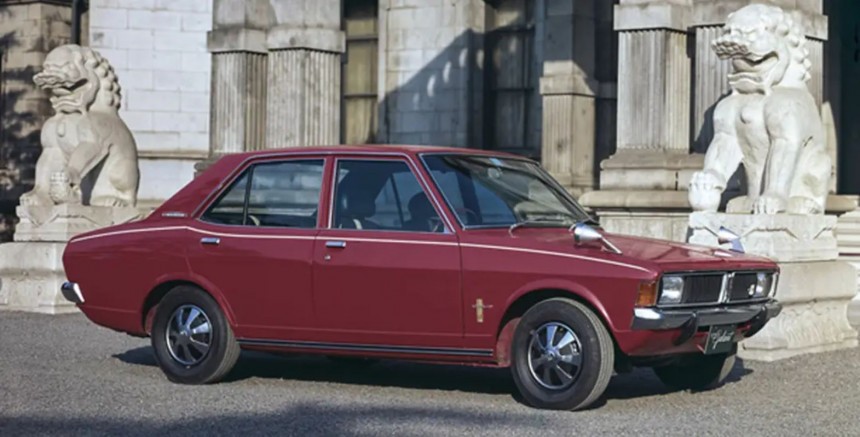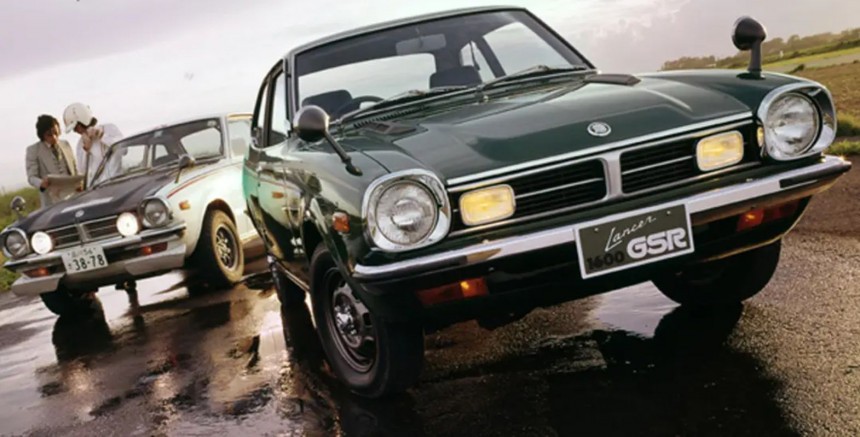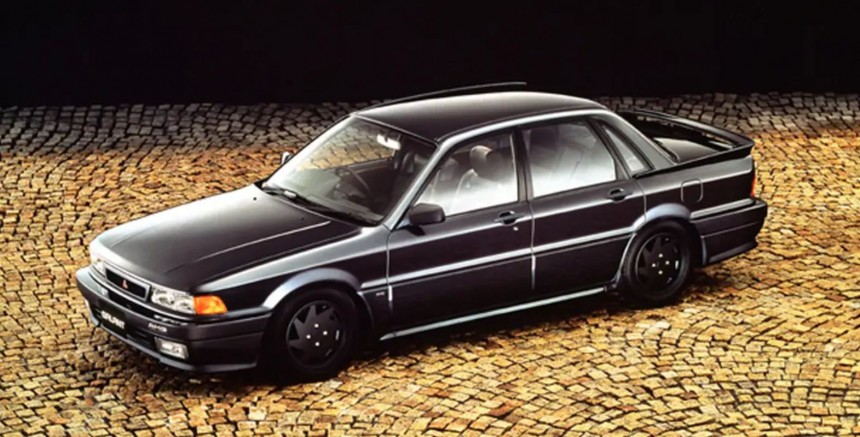While it is hard to believe that a brand like Mitsubishi was once the best team in the rally and created some great cars, you need to know that in the 1990s, the Japanese brand was among the most respected.
The main suspect for this was the Lancer Evolution, best known as the Evo, a name feared by opponents around the world. The Evo was a technology pioneer full of incredibly brave and crazy decisions, driven by courageous people and pushed beyond some unimaginable limits. Today, we will talk about how the Japanese manufacturer went to the top of the rally world and how the Lancer Evo was born.
If we take a look at history, we can see that dynasties rarely begin with a strong start. Usually, it's a prolonged build-up, with every generation placing a brick to create this legendary wall. Mitsubishi is most known as a little car company from Japan that peaked in the 1990s, but they actually began producing cars over 100 years ago. For example, their first innovation came all the way back in 1917, with the PX33 model, which at the time was Japan's first sedan made with a full-time four-wheel drive system. However, three decades later, the war came, and with that, the bitter defeat for Japan, but that's another story for another time.
By the 1950s, Japanese companies had formed Zaibatsu, a conglomerate of companies and industries united for a specific cause. Unfortunately for them, the Allies ordered this 'Justice League' to disband, and Mitsubishi was forced to switch to safe civilian cars. In those 50 years since the appearance of the PX33, Mitsubishi essentially created trucks, buses, scooters, and others. By the 1960s, Japan was hit by a growing economy and a rise in innovation, fueling the industry for decades.
Thanks to the economy, legends were born, and one of those was the Evo. However, it wasn't that simple. Before the Evo, Mitsubishi released the 500 models in 1962, and of course, they took it racing. The 500 took on the Macau Grand Prix and dominated the field. As a result, the win gave the executives at Mitsubishi enough motivation to seriously enter rally racing with their new model, called the Colt. In order to test the Colt, they asked Australian rally driver Doug Stewart for a favor. Right away, Stewart was begging Mitsubishi to enter the vehicle in the Southern Cross International Rally. And they agreed. With two Colt models running in the rally, they finished third and fourth overall. While it wasn't a victory, the Japanese manufacturer's rally heart started to beat.
The team continued to race the Colt for years. The car never achieved victory, but it was competitive enough to inspire the following generations. As a result, in 1971, the new Mitsubishi Galant became the weapon of choice. A year later, a Scottish farmer turned racer (Andrew Cowan) was signed on to the official rally team. Cowan is the same guy who would later open and run Ralliart in Europe and lead Mitsubishi to greatness. Despite a challenging season with a lot of difficulties, the Galant finished 24 minutes ahead of its closest rival, the Nissan 240Z. At the same time, they destroyed manufacturers like Toyota, Honda, and Subaru. For five years, the team went undefeated, and in 1973 they were so good they took the top four spots. Oh, in the same year, the World Rally Championship (WRC) was created.
Mitsubishi had some good moments on the rally scene in the 1970s, so it seems logical that the automaker would officially enter these kind of races. Well, no, they didn't, but a determined man in a Mitsubishi did compete. That man was Joginder Singh, better known as 'The Flying Sikh", a modern marvel that was so ambitious and loyal to racing that he brought Mitsubishi to the world stage. Basically, he was an Indian man living in Kenya, and by 1971, he earned legendary status in the African rally scene. Two years later, he wanted to compete in the WRC. As a result, he bought himself a Galant 16L GS and entered the championship on his own.
One year later, he made another purchase for rally purposes, this time a Lancer 1600 GSR. The difference was that now, Mitsubishi (who wanted to enter on their own) was impressed and sent him rally-specific parts they had developed. He got support from the factory but without using the official brand. In the entire Safari Rally, the Lancer was the least powerful car, but that did not stop him from achieving Mitsubishi's first-ever WRC victory. The Japanese manufacturer finally woke up and made Joginder Singh a part of the team. As a result, he and Cowan brought the squad a number of victories, including a podium lockout in 1976. And all these victories brought a stop to racing for Mitsubishi. Yeah, I know, they do not sound like the most visionary company in the world.
They knew they couldn't match the pace of manufacturers like Lancia or Ford. Besides, in 1980, Audi had the legendary Quattro. It was clear to everyone that the age of rear-wheel drive cars was gone. Truthfully, there was an attempt to create a competitive Lancer in the early 1980s, but the best they could do was four minutes behind the Quattro. A decent result compared to the most dominant rally car from those times. The team clearly needed to restructure, re-engineer and, most importantly, bring a four-wheel drive platform.
Especially in the United States, the rally is a very overlooked motorsport, but 40 years ago, it had captured the world's ears and eyes, primarily thanks to the Group B. Turbo power units and all-wheel drive systems rocketed rally into Formula 1 level of popularity and excitement. Some of the fastest and most dangerous cars were piloted by incredibly brave people, screaming from the exhaust while driving really close to the spectators. How can you not like that?
Mitsubishi knew they needed to beat Audi Quattro, so they followed their AWD formula. As a result, the new platform was their new flagship sports car, the Starion. Andrew Cohen, who was now running Ralliart in Europe, was given the lead. However, they needed a spy, an inside man, to beat Audi. So, they brought Alan Wilkinson, the one who had helped develop the Quattro itself. Unlike the Audi, with its all-wheel drive, the Starion was actually a four-wheel drive, using the Pajero/Montero transfer case. Basically, they stripped the Starion down to just the bare essentials. What was left was made out of polycarbonate for windows and lightweight bodywork. How did that help? Well, the Starion 4WD weighed only 2100 pounds (953 kg). Besides, this car also received an early version of the now legendary 4G63 engine, putting out a rumored 355 hp.
It was a serious effort by Mitsubishi to compete in Group B. Unfortunately, by the time the Japanese manufacturer was completely ready with the Starion, a dark cloud fell on Group B in 1986 due to so many fatalities. While the Starion 4WD competed in some prototype races, it never got the chance to show more. However, all was not lost because Group A homologation rules came around in the mid-1980s, and now it was time for Mitsubishi to shine.
In 1987, the Galant VR4 was launched for the whole world. A four-wheel drive sedan with four-wheel steering, four cylinders, four doors, and a 4G63 engine. Everything about this car has something to do with the number four. Mitsubishi fielded two factory teams with the Galant VR4. The works team would take part in the European side of the WRC, and the other one would compete in the Asia Pacific Rally Championship. In the European competition, the Ralliart squad managed little success. They won a few rallies in the first year and managed two third-place finishes in the manufacturers' championship, but it wasn't the results Mitsubishi hoped for. Then, in 1993, the WRC group rules changed once again.
The new rules favored smaller cars; in comparison, the Galant was a pretty large and heavy vehicle at that time. As a result, the Japanese manufacturer resurrected an old legend, the Lancer. At that time, the Lancer had faded from glory, and it was just a three-box sedan based on the mundane Mirage/Colt. Mitsubishi had a lot of work to make it the best rally car. The first and probably most important thing was that they made the Lancer all-wheel drive. They had perfected the drivetrain with the Starion 4WD. Coupled with a viscous limited-lip differential, the new Lancer would be able to tackle all elements.
The 4G63 had some upgrades and was now capable of near-limitless power. While it was a great start, and Lancer evolved considerably, Mitsubishi knew it wasn't enough. After all that, the team still had some wild and crazy ideas. In 1993, Andrew Cohan was in charge of the Lancer Evolution Program and had this revolutionary idea to make car engineers go to the races. This combination will motivate Mitsubishi to redesign the Evo constantly. And I am not joking, because this thing had six generations in seven years. In contrast, Toyota Celica had two generations, while the Subaru WRX had only one.
When the first generation of the Evo debuted on the hill roads of Monte Carlo, all eyes were on Toyota and Ford. Nobody was paying attention to the back of the pack, where one of the greatest rivalries ever was forming. A little car company nobody cared about named Subaru and a brand that people forgot about pretty quickly.
From this point, the rest is history, and in the future, we will talk about how great this rivalry that shaped the 1990s and influenced the automotive industry for years to come actually was.
If we take a look at history, we can see that dynasties rarely begin with a strong start. Usually, it's a prolonged build-up, with every generation placing a brick to create this legendary wall. Mitsubishi is most known as a little car company from Japan that peaked in the 1990s, but they actually began producing cars over 100 years ago. For example, their first innovation came all the way back in 1917, with the PX33 model, which at the time was Japan's first sedan made with a full-time four-wheel drive system. However, three decades later, the war came, and with that, the bitter defeat for Japan, but that's another story for another time.
By the 1950s, Japanese companies had formed Zaibatsu, a conglomerate of companies and industries united for a specific cause. Unfortunately for them, the Allies ordered this 'Justice League' to disband, and Mitsubishi was forced to switch to safe civilian cars. In those 50 years since the appearance of the PX33, Mitsubishi essentially created trucks, buses, scooters, and others. By the 1960s, Japan was hit by a growing economy and a rise in innovation, fueling the industry for decades.
Thanks to the economy, legends were born, and one of those was the Evo. However, it wasn't that simple. Before the Evo, Mitsubishi released the 500 models in 1962, and of course, they took it racing. The 500 took on the Macau Grand Prix and dominated the field. As a result, the win gave the executives at Mitsubishi enough motivation to seriously enter rally racing with their new model, called the Colt. In order to test the Colt, they asked Australian rally driver Doug Stewart for a favor. Right away, Stewart was begging Mitsubishi to enter the vehicle in the Southern Cross International Rally. And they agreed. With two Colt models running in the rally, they finished third and fourth overall. While it wasn't a victory, the Japanese manufacturer's rally heart started to beat.
Mitsubishi had some good moments on the rally scene in the 1970s, so it seems logical that the automaker would officially enter these kind of races. Well, no, they didn't, but a determined man in a Mitsubishi did compete. That man was Joginder Singh, better known as 'The Flying Sikh", a modern marvel that was so ambitious and loyal to racing that he brought Mitsubishi to the world stage. Basically, he was an Indian man living in Kenya, and by 1971, he earned legendary status in the African rally scene. Two years later, he wanted to compete in the WRC. As a result, he bought himself a Galant 16L GS and entered the championship on his own.
One year later, he made another purchase for rally purposes, this time a Lancer 1600 GSR. The difference was that now, Mitsubishi (who wanted to enter on their own) was impressed and sent him rally-specific parts they had developed. He got support from the factory but without using the official brand. In the entire Safari Rally, the Lancer was the least powerful car, but that did not stop him from achieving Mitsubishi's first-ever WRC victory. The Japanese manufacturer finally woke up and made Joginder Singh a part of the team. As a result, he and Cowan brought the squad a number of victories, including a podium lockout in 1976. And all these victories brought a stop to racing for Mitsubishi. Yeah, I know, they do not sound like the most visionary company in the world.
They knew they couldn't match the pace of manufacturers like Lancia or Ford. Besides, in 1980, Audi had the legendary Quattro. It was clear to everyone that the age of rear-wheel drive cars was gone. Truthfully, there was an attempt to create a competitive Lancer in the early 1980s, but the best they could do was four minutes behind the Quattro. A decent result compared to the most dominant rally car from those times. The team clearly needed to restructure, re-engineer and, most importantly, bring a four-wheel drive platform.
Mitsubishi knew they needed to beat Audi Quattro, so they followed their AWD formula. As a result, the new platform was their new flagship sports car, the Starion. Andrew Cohen, who was now running Ralliart in Europe, was given the lead. However, they needed a spy, an inside man, to beat Audi. So, they brought Alan Wilkinson, the one who had helped develop the Quattro itself. Unlike the Audi, with its all-wheel drive, the Starion was actually a four-wheel drive, using the Pajero/Montero transfer case. Basically, they stripped the Starion down to just the bare essentials. What was left was made out of polycarbonate for windows and lightweight bodywork. How did that help? Well, the Starion 4WD weighed only 2100 pounds (953 kg). Besides, this car also received an early version of the now legendary 4G63 engine, putting out a rumored 355 hp.
It was a serious effort by Mitsubishi to compete in Group B. Unfortunately, by the time the Japanese manufacturer was completely ready with the Starion, a dark cloud fell on Group B in 1986 due to so many fatalities. While the Starion 4WD competed in some prototype races, it never got the chance to show more. However, all was not lost because Group A homologation rules came around in the mid-1980s, and now it was time for Mitsubishi to shine.
In 1987, the Galant VR4 was launched for the whole world. A four-wheel drive sedan with four-wheel steering, four cylinders, four doors, and a 4G63 engine. Everything about this car has something to do with the number four. Mitsubishi fielded two factory teams with the Galant VR4. The works team would take part in the European side of the WRC, and the other one would compete in the Asia Pacific Rally Championship. In the European competition, the Ralliart squad managed little success. They won a few rallies in the first year and managed two third-place finishes in the manufacturers' championship, but it wasn't the results Mitsubishi hoped for. Then, in 1993, the WRC group rules changed once again.
The 4G63 had some upgrades and was now capable of near-limitless power. While it was a great start, and Lancer evolved considerably, Mitsubishi knew it wasn't enough. After all that, the team still had some wild and crazy ideas. In 1993, Andrew Cohan was in charge of the Lancer Evolution Program and had this revolutionary idea to make car engineers go to the races. This combination will motivate Mitsubishi to redesign the Evo constantly. And I am not joking, because this thing had six generations in seven years. In contrast, Toyota Celica had two generations, while the Subaru WRX had only one.
When the first generation of the Evo debuted on the hill roads of Monte Carlo, all eyes were on Toyota and Ford. Nobody was paying attention to the back of the pack, where one of the greatest rivalries ever was forming. A little car company nobody cared about named Subaru and a brand that people forgot about pretty quickly.
From this point, the rest is history, and in the future, we will talk about how great this rivalry that shaped the 1990s and influenced the automotive industry for years to come actually was.






















